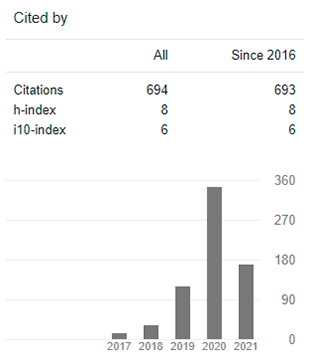COVID-19 Pandemic and Virtualization of Classrooms: The Importance of Play
DOI:
https://doi.org/10.29394/Scientific.issn.2542-2987.2020.5.17.20.370-383Keywords:
social isolation, education, play, digitizationAbstract
Currently, the pandemic that affects the entire planet has produced changes. Putting us in context and according to Arrizabalaga (1992): the word “pandemic” etymologically comes from the Greek expression pandêmonnosêma, translated as disease of the entire people, this has led to different decisions being made to approach the teaching-learning process. This essay seeks to collate the importance of play and the generation of playful learning instances in this new methodology imposed by the health contingency. To achieve the analysis of the object of study, a systematic review was carried out from formal sources, of the effects of the use of screens, of teacher digitization and of how to enhance these instruments in order to achieve the learning results.
Downloads
References
Aliño, M., Navarro, R., López, J. y Pérez, I. (2007). La edad preescolar como momento singular del desarrollo humano. Revista Cubana de Pediatría, 79(4), 1-13, e-ISSN: 1561-3119. Recuperado de: http://scielo.sld.cu/scielo.php?script=sci_arttext&pid=S0034-75312007000400010
Arrizabalaga, J. (1992). Nuevas tendencias en la historia de la enfermedad: a propósito del constructivismo social. Arbor, (558-560), 147-166, ISSN: 0210-1963. España: Consejo Superior de Investigaciones Científicas - CSIC.
Bruner, J. (1973). Beyond the Information Given: Studies in the Psychology of Knowing. ISBN: 0393093638, ISBN: 9780393093636. United States: W. W. Norton, Incorporated.
Deterding, S., Dixon, D., Khaled, R., & Nacke, L. (2011). Gamification: Toward a Definition. In CHI 2011 Gamification Workshop Proceedings. Vancouver, B.C., Canada: Gamification Research Network.
Etchepareborda, M. C., & Abad-Mas, L. (2005). Memoria de trabajo en los procesos básicos del aprendizaje. Revista de neurología electrónica, 40(Supl. 1), S79-S83, e- ISSN: 1576-6578. Recuperado de: https://doi.org/10.33588/rn.40S01.2005078
Farashahi, S., Donahue, C., Khorsand, P., Seo, H., Lee, D., & Soltani, A. (2017). Metaplasticity as a Neural Substrate for Adaptive Learning and Choice under Uncertainty. Neuron, 94(2), P401-414.E6, e-ISSN: 1097-4199. Recovered from: https://doi.org/10.1016/j.neuron.2017.03.044
Franco, Y. (2017). Rol del Tutor en el Contexto del Aprendizaje Virtual. Revista Scientific, 2(6), 270-285, e-ISSN: 2542-2987. Recuperado de: https://doi.org/10.29394/scientific.issn.2542-2987.2017.2.6.14.270-285
Gallese, V., Keysers, C., & Rizzolatti, G. (2004). A unifying view of the basis of social cognition. Trends in Cognitive Sciences, 8(9), 396-403, e-ISSN: 1364-6613. Recovered from: https://doi.org/10.1016/j.tics.2004.07.002
García, F., Portillo, J., Romo, J., & Benito, M. (2007). Nativos digitales y modelos de aprendizaje. Ceur Workshop Proceedings, 318, 1-11, e- ISSN: 1613-0073. Recuperado de: http://ceur-ws.org/Vol-318/Garcia.pdf
Gibbs, R. (2012). Embodiment and Cognitive Science. ISBN: 9780511805844. Cambridge, Inglaterra: Cambridge University Press.
Giordano, N., Iemolo, A., Mancini, M., Cacace, F., De Risi, M., Latagliata, E., … De Leonibus, E. (2018). Motor learning and metaplasticity in striatal neurons: relevance for Parkinson’s disease. Brain, 141(2), 505-520, ISSN: 0006-8950, e-ISSN: 1460-2156. Recovered from: https://doi.org/10.1093/brain/awx351
Gutiérrez, P., Osorio, N., Rincón, E., Toloza, B., & Vega, M. (2018). Estrategia lúdico-pedagógica dirigida a niños y niñas de transición para el fortalecimiento de la atención sostenida en su proceso de aprendizaje. Boletín Redipe, 7(7), 107-128, e-ISSN: 2256-1536. Recuperado de: https://revista.redipe.org/index.php/1/article/view/524
Huizinga, J. (1972). Homo Ludens. Buenos Aires, Argentina: JC Sáez Editor.
Lazar, S., Kerr, C., Wasserman, R., Gray, J., Greve, D., Treadway, M., … Fischl, B. (2005). Meditation experience is associated with increased cortical thickness. NeuroReport, 16(17), 1893-1897, e-ISSN: 0959-4965. Recovered from: https://doi.org/10.1097/01.wnr.0000186598.66243.19
Meneses, M., Monge, M. (2001). El juego en los niños: enfoque teórico. Educación, 25(2), 113-124, e-ISSN: 0379-7082. Recuperado de: https://www.redalyc.org/articulo.oa?id=44025210
Moreno, B. (2014). Acción y cognición: una educación física de la acción presente. Educación Física y Ciencia, 16(2), 1-9, e-ISSN: 2314-2561. Recuperado de: https://www.efyc.fahce.unlp.edu.ar/article/view/EFyCv16n02a04
Otálvaro, S. (2011). El juego en la dimensión infantil: Aprendizaje e intersubjetividad. Revista de educación y pensamiento, (18), 24-33, e-ISSN: 1692-2697. Recuperado de: https://dialnet.unirioja.es/servlet/articulo?codigo=3884434
Peña, J. (2017). Herramientas de Comunicación Virtual para la Práctica Docente. Revista Scientific, 2(Ed. Esp.), 194-214, e-ISSN: 2542-2987. Recuperado de: https://doi.org/10.29394/scientific.issn.2542-2987.2017.0.0.11.194-214
Pin, G., Merino, M., De la Calle, T., Hidalgo, M., Rodríguez, P., Soto, V. & Madrid, J. (2014). Consenso sobre el uso de melatonina en niños y adolescentes con dificultades para iniciar el sueño. Anales de Pediatría, 81(5), 328.e1-328.e9, ISSN: 1695-4033, e-ISSN: 1696-4608. Recuperado de: https://doi.org/10.1016/j.anpedi.2014.03.011
Rizzolatti, G. (2005). The mirror neuron system and its function in humans. Anatomy and Embryology, 210, 419-421, e-ISSN: 1432-0568. Recovered from: https://doi.org/10.1007/s00429-005-0039-z
Rodríguez, A., Ramírez, L. & Basile, F. (2017). Tecnologías y Educación: Su Percepción Social En Santiago de Chile. Formación Universitaria, 10(6). 67-76, e-ISSN: 0718-5006. Recuperado de: https://dialnet.unirioja.es/servlet/articulo?codigo=6229754
Sasaki, Y., Nanez, J., & Watanabe, T. (2010). Advances in visual perceptual learning and plasticity. Nature Reviews Neuroscience, 11, 53-60, e-ISSN: 1471-0048. Recovered from: https://doi.org/10.1038/nrn2737
Suárez, J., Almerich, G., Gargallo, B., & Aliaga, F. (2010). Las competencias en TIC del profesorado y su relación con el uso de los recursos tecnológicos. Archivos Analíticos de Políticas Educativas, 18(1), 1-33, e-ISSN: 1068-2341. Recuperado de: https://dialnet.unirioja.es/servlet/articulo?codigo=3199091
Suárez-Guerrero, C., Lloret-Catalá, C., & Mengual-Andrés, S. (2016). Percepción docente sobre la transformación digital del aula a través de tabletas: Un estudio en el contexto español. Comunicar, 49(24), 81-89, ISSN: 1134-3478, e-ISSN: 1988-3293. Recuperado de: https://doi.org/10.3916/C49-2016-08
Sangrà, A. (2001). Enseñar y aprender en la virtualidad. Educar, 28, 117-131, ISSN: 0211-819X, e-ISSN: 2014-8801. Recuperado de: https://educar.uab.cat/article/view/v28-sangra
Varela, F. (1996). Neurophenomenology: A Methodological Remedy for the Hard Problem. Journal of Consciousness Studies, 3(4), 330-349, e-ISSN: 2051-2201. Recovered from: https://unstable.nl/andreas/ai/langcog/part3/varela_npmrhp.pdf
Vartak, D., Jeurissen, D., Self, M., & Roelfsema, P. (2017). The influence of attention and reward on the learning of stimulus-response associations. Scientific Reports, 7, 1-12, e-ISSN: 2045-2322. Recovered from: https://www.nature.com/articles/s41598-017-08200-w
Verdejo-García, A., & Bechara, A. (2010). Neuropsicología de las Funciones Ejecutivas. Psicothema, 22(2), 227-235, ISSN: 0214-9915. Recuperado de: http://www.psicothema.com/psicothema.asp?id=3720
Villasana, N., & Dorrego, E. (2007). Habilidades sociales en entornos virtuales de trabajo colaborativo. RIED: revista iberoamericana de educación a distancia, 10(2), 45-74, ISSN: 1138-2783, e-ISSN: 1390-3306. Recuperado de: https://doi.org/10.5944/ried.2.10.993
Downloads
Published
How to Cite
Issue
Section
License
The content of the journals of this site, are under a Creative Commons Attribution-Noncommercial-Share Alike 4.0 International License.













